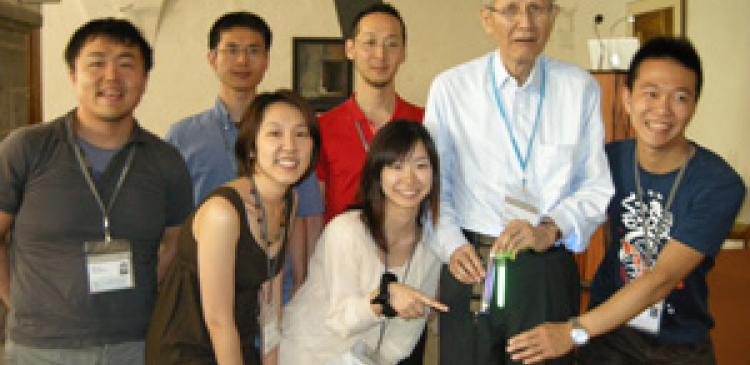The latest set of lectures took place on 5 December 2009 at the Marunouchi Building Hall in central Tokyo, in what was the 31st year of the event. The program was dominated by the theme of infectious diseases and was the second in a four-year series focusing on the role of RIKEN, as Japan’s largest research institute devoted to the natural sciences, in tackling problems of health, environment and energy. The 2009 lecture series occurred against a backdrop of fear about a global H1N1 influenza pandemic, further emphasizing the importance of research on treatments for infectious diseases.
Between 27 June and 2 July 2010,61 Nobel laureates gathered with more than 650 young researchers from around the globe for the 2010 Lindau Meeting of Nobel Laureates in the small town of Lindau, Germany. In addition to RIKEN President Ryoji Noyori, who was invited to Lindau as one of the Nobel laureates at the event, five young researchers from RIKEN centers and institutes also attended this year’s meeting.
Malaysian researcher Li Foong Yoong of the RIKEN Brain Science Institute, whose research explores developmental mechanisms that control complex neuron morphology, was one of these five attendees. In the article below, Yoong recounts how the inspiring words of Nobel laureates at the meeting, and encounters with leading young researchers from many different nationalities, brought a renewed sense of excitement to her research work and reignited her passion for science.
Inspired by Lindau
RIKEN delegates to the Lindau Meeting with Nobel Laureate Osamu Shimomura (second from right), discoverer of green fluorescent protein.This year, nominated and sponsored by the Human Frontier Science Program, I had the great fortune to attend the 2010 Lindau Meeting of Nobel Laureates. This is the third year in which the meeting has focused on interdisciplinary dialogue, bringing together Nobel laureates and young scientists from across the fields of physics, chemistry and medicine/physiology.
As someone working in the field of neurobiology, the Nobel lectures on medicine and physiology were naturally of particular interest to me. To hear the history of the work that led to great discoveries in these fields, the twists and turns involved, was intensely inspiring. The lectures on physics and chemistry were also fascinating in their own way. I have only ever attended meetings and conferences in my own field of research, and thus learning about the topics presented in these lectures was an eyeopening experience for me.
Beside the lectures, there were also many other social events on the program that allowed close interaction between the laureates and young researchers. Dinner was one of these, offering us the chance to speak to the laureates and talk about science while enjoying local food and culture. One of my fondest memories from the Lindau Meeting was of interacting with highly talented young researchers from countless countries and research backgrounds. I will always remember the breaks and meal times spent sitting by the beautiful and peaceful Lake Constance, deeply engaged in discussions and debates with these new friends.
Lindau attendees from the Human Frontier Science Program.Two other memories from the Lindau Meeting stand out in my mind. The first was a lecture by Dr Osamu Shimomura, who discussed green fluorescent proteins (GFPs). While I use GFPs routinely in my own research, this was the first time for me to attend a lecture by Dr Shimomura and actually meet him in person. He is a very humble scientist, but he amazed all of us at the end of his lecture when he vividly demonstrated the bright green florescent light of GFP by shining an ultraviolet light on a glass tube containing purified GFP.
The second memory I have is of the World Cup football games, which were taking place during the Lindau Meeting. The World Cup and the Lindau Meeting were huge international events that filled the small town of Lindau with passion. With a group of young Japanese researchers, I cheered for the Japanese team in the Japan versus Paraguay game, which we watched together with other international attendees. In this way, both inside and outside of the lecture room, I established strong friendships with other young researchers at Lindau.
The Lindau Meeting has offered me more than I could have imagined. One week in Lindau, away from the bench, was like a rejuvenating vacation for my mind, which is so constantly occupied with work. I came back with a fresh perspective on my research and a reignited passion for science. The wisdom of Nobel laureates and the enthusiasm of fellow young researchers have reminded me once again of the simple joys of science.





